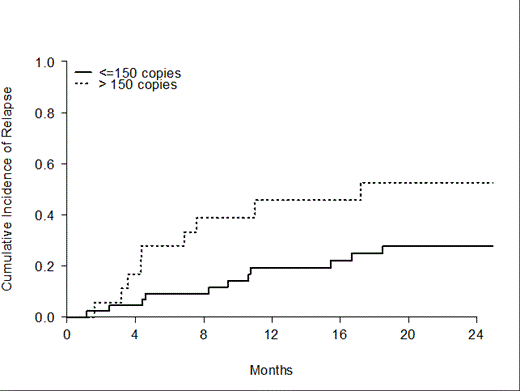Abstract
Introduction
Evaluation of WT1 expression is becoming an attractive marker in acute myeloid leukaemia (AML) for minimal residual disease (MRD) detection. Recent studies correlate therapy response with WT1 copy levels in the bone marrow (BM) offering an additional tool beside multiparameter flow-cytometry (MFC). No well-known data are available regarding its impact on the outcome after hematopoietic cell transplantation (HCT).
Patients/Methods
One hundred and two consecutive clinically and molecularly well characterized AML patients (pts) were transplanted in a single hematology center from 2004 to 2013. Indication for allogeneic HCT included high cytogenetic and molecular risk according to WHO criteria, high leukocytosis, extramedullary manifestations or secondary AML at diagnosis. Further, primary induction failure was considered as an indication for allogeneic HCT.
WT1 expression was analyzed by real time polymerase chain reaction (RT-PCR), using the standardized European LeukemiaNet method on BM samples before HCT and during each follow up control. Only pts in first CR before HCT were included in the analysis.
Cumulative incidence of relapse (CIR) was estimated considering death for other causes than relapse as a competing event. Univariate and multivariate Fine & Gray Regression models were used to test the association between CIR and pre-HCT BM WT1 levels. Linearity of the relationship between CIR and the WT1 level was investigated using a mathematical transformation (restricted cubic spline).
Aim of this retrospective analysis was to investigate the impact of pre-HCT BM WT1 expression in first CR pts on predicting relapse after HCT.
Results
A BM WT1 evaluation pre-HCT was available in 89 out of 102 pts. Among them, 62 achieved a CR after induction treatment. Relapsed pts in CR after reinduction chemotherapy (n=16) or with disease persistence pre-HCT (n=2) and pts refractory to treatment (n=9) were excluded from analysis.
The patient subgroup displaying a first CR before HCT had a median age at diagnosis of 49 years (range: 20-65). Patient/donor relationship involved 26 (42%) sibling, 32 (52%) matched unrelated and 4 (6%) haplo-identical donors. On the basis of standard cytogenetics, molecular biology and clinical criteria (global disease risk) pts were classified according to the following risk groups: 54 (87%) high, 5 (8%) intermediate and 3 (5%) low risk. Acute GVHD occurred in 24 (39%) whereas chronic GVHD was documented in 18 (28%) pts. Twenty-six (42%) deaths were documented after HCT, 21 (34%) due to relapse and 5 (8%) because of treatment related mortality (TRM).
Pre-HCT BM WT1 expression was correlated with CIR. A cut point of 150 WT1 copies was applied according to the slope change of relapse hazard, and subsequently used for CIR analysis. Pts displaying a pre-HCT BM WT1 level > 150 copies (n=18) had a higher CIR (2-year CIR 52.5%, 95% CI: 27.1-77.8) compared to pts with a BM WT1 level ≤ 150 copies (n=44, 2-year CIR 27.7% (95% CI: 13.4-42.1). WT1 copy level > 150 showed a significantly higher risk of relapse in univariate analysis (HR 2.9, 95% CI 1.2-6.7, p=0.014). In multivariate analysis pre-HCT BM WT1 expression was confirmed as a significant independent risk factor for CIR when adjusted for patient/donor relationship, presence of GVHD, global disease risk and competitive risk of mortality due to TRM (HR 3.4, 95% CI 1.3-8.5, p=0,010), Figure.
Conclusions In the present study, pre-HCT BM WT1 levels discriminated significantly for CIR in a cohort of AML in first CR. A cut off level of 150 BM WT1 copies pre-HCT had a powerful statistically significant discriminating value to predict the risk of relapse, independently from already established risk factors. The prognostic value of WT1 was confirmed also when TRM as competitive risk for mortality was added in the multivariable model. Based on these results, WT1 is a promising candidate as MRD tool. Further prospective studies are required to confirm these results.
No relevant conflicts of interest to declare.
Author notes
Asterisk with author names denotes non-ASH members.


